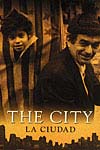The City (La Ciudad) (NR)

synopsis
La Ciudad is a narrative snapshot of a side of New York that is rarely seen: the city of illegal immigrants, the homeless, seasonal workers, sweatshops, and laborers from Manhattan's Latin American neighborhoods. An intensive collaboration with the immigrant community over a five-year period has resulted in a complex four-part narrative in which the subjects of the film are its principal actors. Set in the present day, the film follows four separate stories of immigrant life. A young laborer, scavenging for bricks, is killed when a wall collapses; two teenagers from the same village fall in love, then lose each other in a housing project; a homeless father tries to enroll his daughter in school; a young garment worker seeks justice in the sweatshops. The film begins with formal references to conventions which recall the classic tradition of still photography and documentary films of the 1930s: gorgeously lit black-and-white portraits of workers, families, street life, and ordinary labor. It quickly develops into a narrative reminiscent of Italian neorealism of the 1940s: mostly nonprofessional actors engaged in the tragedies and redemptions of everyday life. Uprooted, disenfranchised, exploited, and heroic in their strivings, these characters and stories have the stuff of greats such as Pare Lorentz, Dorothea Lange, Joris Ivens, Helen Levitt, Roberto Rossellini, and Vittorio De Sica. Paradoxically, there is nothing either retro-hip or postmodern about this film. Its clarity, power, and contemporaneity produce a fresh and serious new work that is completely engaging.
details
Drama
1 hr. 28 min.
Opened January 22nd, 1999

To get the full Quicklook Films experience, uncheck "Enable on this Site" from Adblock Plus
synopsis
La Ciudad is a narrative snapshot of a side of New York that is rarely seen: the city of illegal immigrants, the homeless, seasonal workers, sweatshops, and laborers from Manhattan's Latin American neighborhoods. An intensive collaboration with the immigrant community over a five-year period has resulted in a complex four-part narrative in which the subjects of the film are its principal actors. Set in the present day, the film follows four separate stories of immigrant life. A young laborer, scavenging for bricks, is killed when a wall collapses; two teenagers from the same village fall in love, then lose each other in a housing project; a homeless father tries to enroll his daughter in school; a young garment worker seeks justice in the sweatshops. The film begins with formal references to conventions which recall the classic tradition of still photography and documentary films of the 1930s: gorgeously lit black-and-white portraits of workers, families, street life, and ordinary labor. It quickly develops into a narrative reminiscent of Italian neorealism of the 1940s: mostly nonprofessional actors engaged in the tragedies and redemptions of everyday life. Uprooted, disenfranchised, exploited, and heroic in their strivings, these characters and stories have the stuff of greats such as Pare Lorentz, Dorothea Lange, Joris Ivens, Helen Levitt, Roberto Rossellini, and Vittorio De Sica. Paradoxically, there is nothing either retro-hip or postmodern about this film. Its clarity, power, and contemporaneity produce a fresh and serious new work that is completely engaging.
details
Drama
1 hr. 28 min.
Opened January 22nd, 1999






